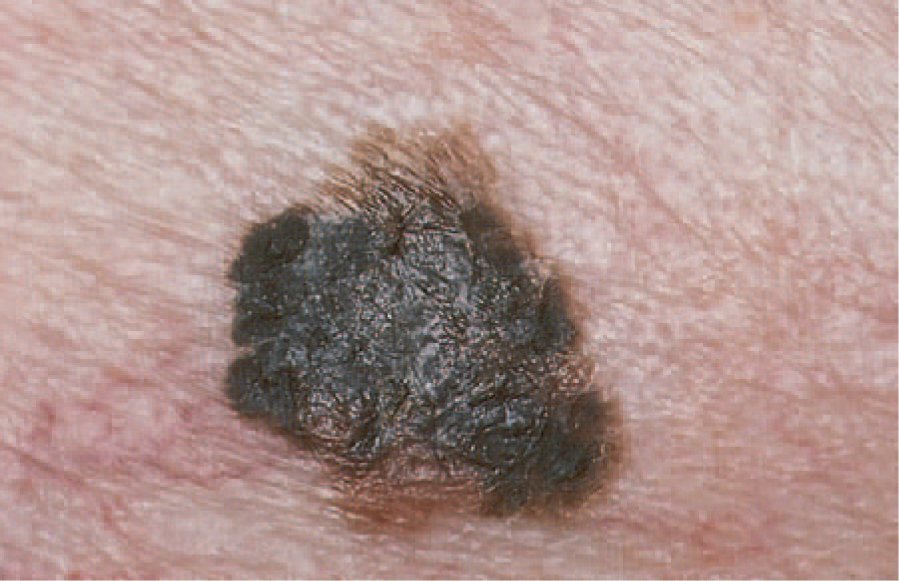Deadly Melanoma May Not Show Up as a Mole

It's a good idea to keep an eye on your moles, to see if any of them are changing, which can be a sign of skin cancer, experts agree. But a new study finds that the sometimes-deadly skin cancer melanoma usually arises in normal skin, where there is no dark spot or sign of cancer until the melanoma suddenly shows up.
Moreover, melanomas that arise in non-mole areas of the skin tend to be more aggressive and deadly than those that do arise from moles, the study found.
"We find that the ones without a [mole] appear to be more aggressive," said Dr. David Polsky, the study's lead researcher and a professor of dermatology, pathology and dermatologic oncology at New York University School of Medicine. "We think that there are biological differences" between melanomas that develop within moles and those that develop elsewhere on the skin, and it's possible that these differences underlie the difference in aggressiveness, he said. [10 Do's and Don'ts to Reduce Your Risk of Cancer]
Further research into the differences between mole and non-mole melanomas could lead researchers to develop better treatments for the cancer, he said. The National Cancer Institute estimates that 74,000 people in the United States will be diagnosed with melanoma during 2015, and about 10,000 people in the country will die of the disease this year.
In the new study, the scientists looked at 2,250 people with melanoma. They noted the type of melanoma each person had (whether it was mole-related or nonmole-related), and examined factors such as the person's age, the location of the melanoma on the body, tumor thickness, stage of the disease and survival rate. (Not all marks on the skin are moles. The naked eye cannot always spot the differences among a regular mole, a mole that has developed into melanoma, and another mark on the skin that is a melanoma, but experts who look at the cells under a microscope can tell the difference.)
People whose melanomas did not arise from moles (called de novo melanomas) tended to do worse than people with mole-associated melanoma, the researchers said in their findings, presented June 1 at the annual American Society of Clinical Oncology meeting.
In general, between 20 and 30 percent of melanomas are mole-associated, but the majority of melanoma cases are de novo cases — they arise in skin that looks normal until the melanoma forms.
Get the world’s most fascinating discoveries delivered straight to your inbox.
The people with de novo melanomas had poorer outcomes than those with melanomas from moles, the researchers said. They were 2.35 times more likely to have cancer that had advanced beyond stage 1 at the time of diagnosis. About 75 percent of people with mole-associated melanoma survived for 10 years after their diagnosis, compared with 60 percent of de novo melanoma patients.
It was already known that melanomas are more aggressive if the tumor is thick, or if the skin is broken or uneven because of the tumor, Polsky said. In the new study, the researchers found that the de novo melanomas were more often associated with these signs of being more aggressive than melanomas that formed in moles were, he told Live Science.
For instance, the researchers found that people with de novo melanomas were about twice as likely to have tumors considered to be thick, and 1.6 times as likely to have broken or uneven skin, compared with people who had mole-related melanomas.
The people with de novo melanoma also tended to be older — the average age of those with de novo melanoma was 54, compared with 47 for those with mole-associated melanoma. De novo melanoma was also more likely to occur on people's arms, legs, head or neck than on the chest, abdomen or back, the researchers noted.
Interestingly, women with melanoma usually have a better survival rate than men with the condition (it's not well understood why), Polsky said. But the new study found that, although women tend to outlive men in cases of de novo melanoma, the two sexes actually have equal survival rates for mole-associated melanoma. [Top 10 Anti-Cancer Foods]
That finding "opens a whole lot of questions of what the biological differences might be between these two types of melanomas. It's very exciting to have some new questions to investigate," Polsky said.
If doctors recognize and treat melanoma in its early stages, the disease is often curable, according to the advocacy group the Skin Cancer Foundation. However, untreated melanomas can advance and spread throughout the body, becoming harder to treat and even fatal, the foundation said.
Both children and young adults often get new moles as they age, and Polsky said people should seek medical attention if they notice an odd-looking mole or lesion on their skin that wasn't there before, or that has changed over time. He recommended using the ABCDE method: Check if spots or growths are asymmetrical, have uneven borders, are dual-colored, are large in diameter or are evolving (changing) over time.
"Most new spots are benign, but they should be checked out if they're changing in their appearance persistently over four to six weeks," Polsky said.
Follow Laura Geggel on Twitter @LauraGeggel. Follow Live Science @livescience, Facebook & Google+. Original article on Live Science.

Laura is the managing editor at Live Science. She also runs the archaeology section and the Life's Little Mysteries series. Her work has appeared in The New York Times, Scholastic, Popular Science and Spectrum, a site on autism research. She has won multiple awards from the Society of Professional Journalists and the Washington Newspaper Publishers Association for her reporting at a weekly newspaper near Seattle. Laura holds a bachelor's degree in English literature and psychology from Washington University in St. Louis and a master's degree in science writing from NYU.



